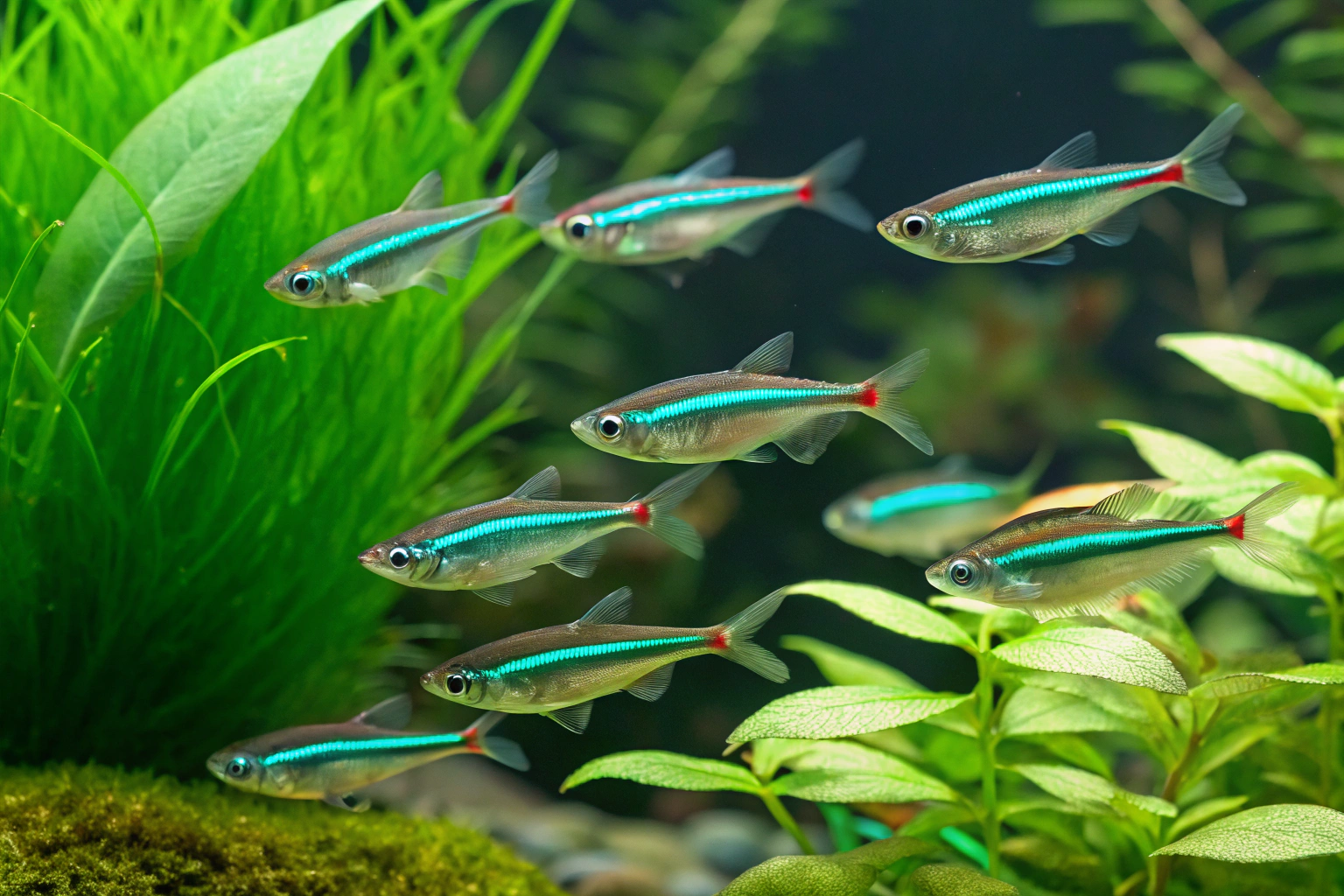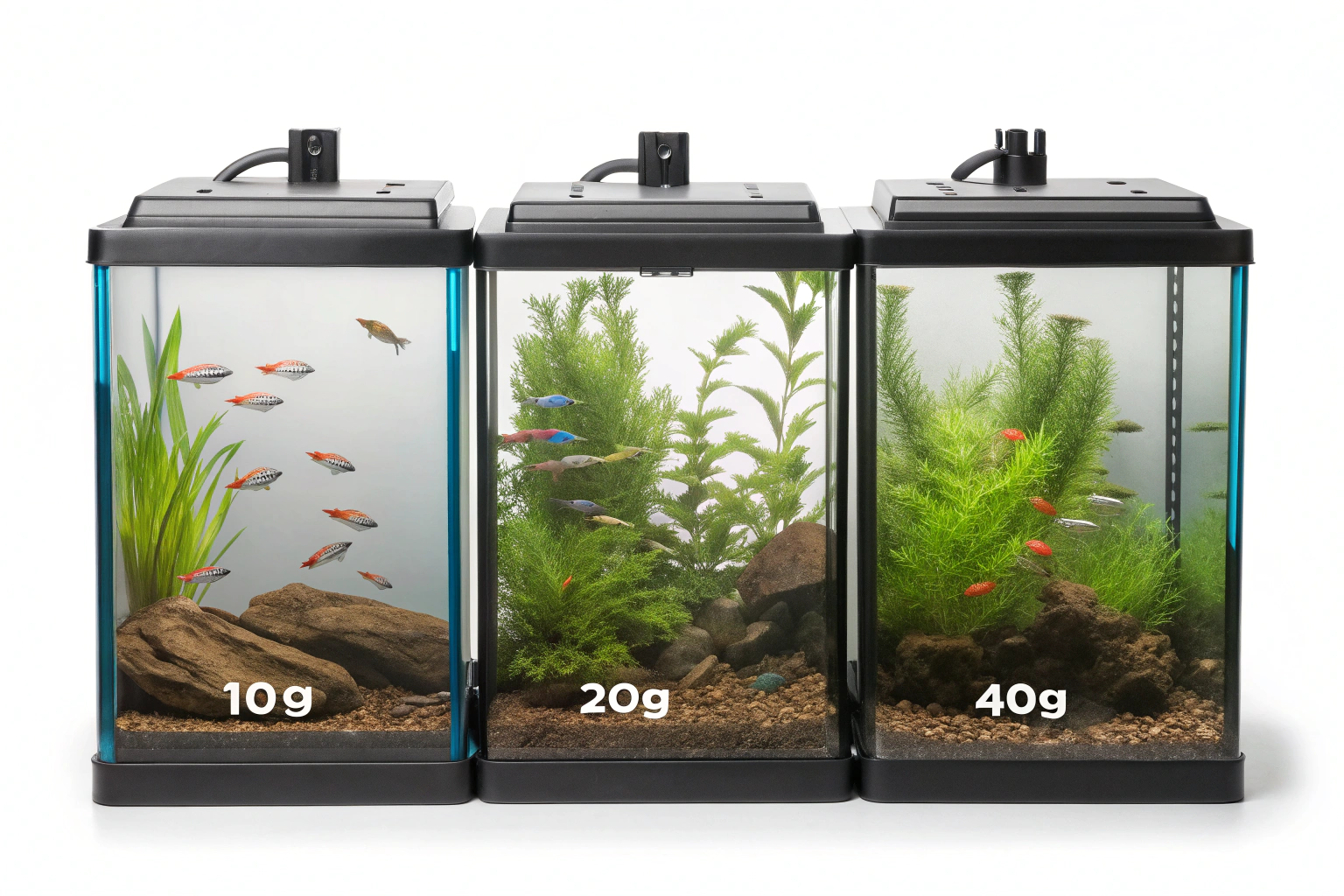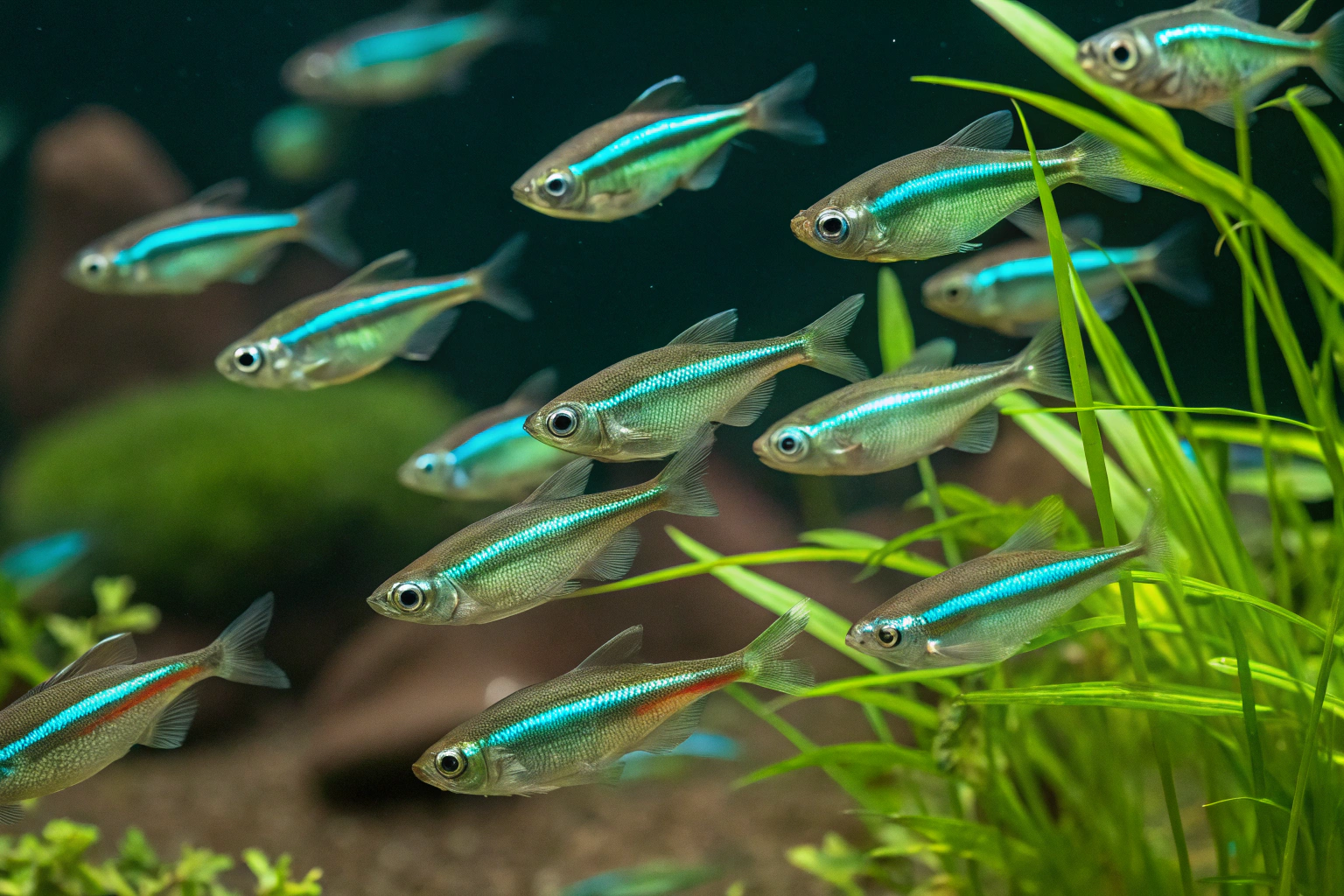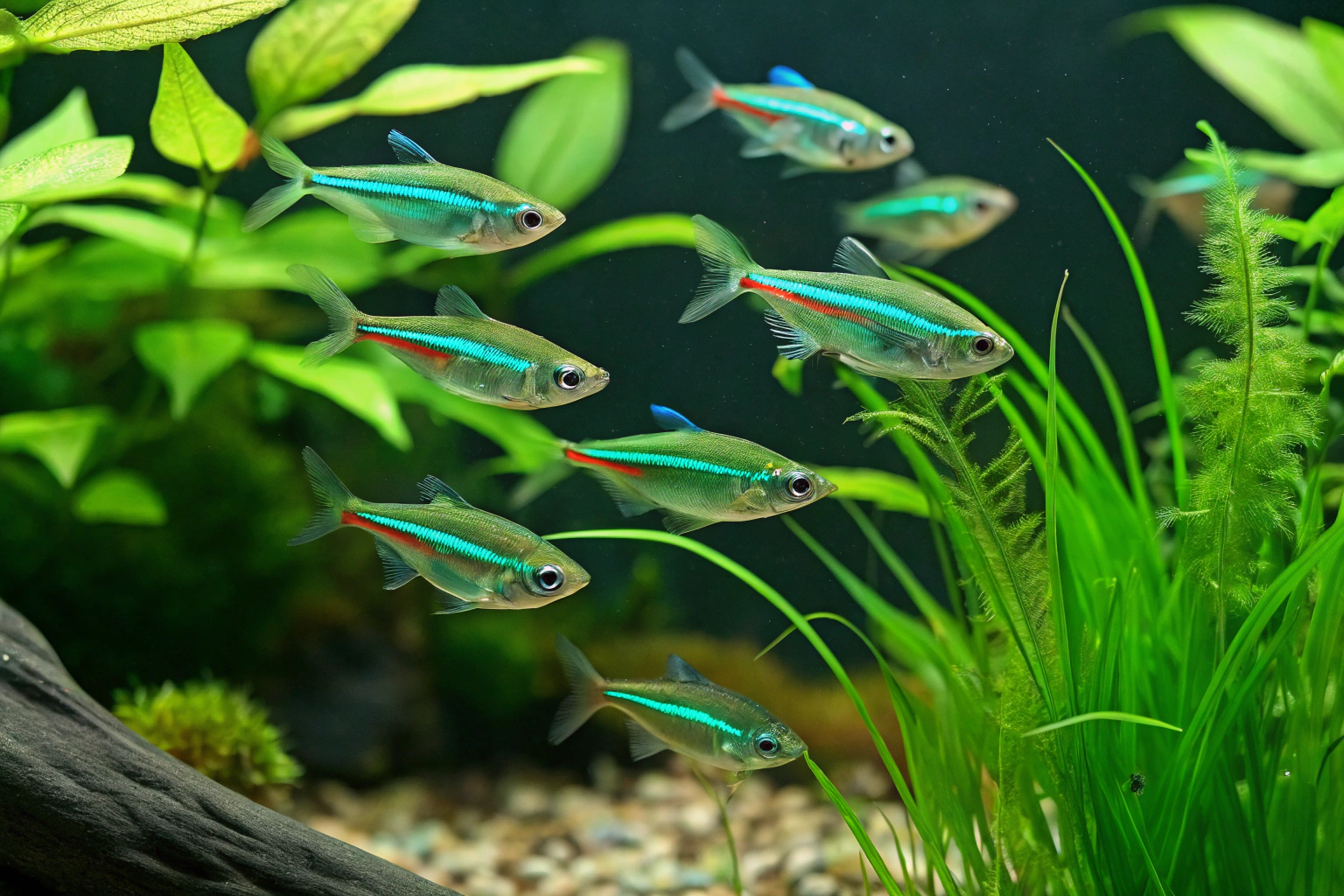How Many Green Neon Tetra Fish Should I Keep Together in My Tank?
This post may contain affiliate links.
Green neon tetras are stunning freshwater fish that captivate aquarium enthusiasts with their brilliant coloration and peaceful nature. However, one of the most crucial questions new aquarists ask is: how many green neon tetra fish should I keep together in my tank? The answer isn’t just about numbers—it’s about understanding their natural schooling behavior, tank requirements, and creating the optimal environment for these magnificent fish to thrive.

Understanding Green Neon Tetra Schooling Behavior
Green neon tetras (Paracheirodon simulans) are inherently schooling fish that exhibit complex social behaviors in their natural Amazon River habitat. In the wild, these fish form large groups of hundreds or even thousands of individuals, creating mesmerizing displays of synchronized swimming patterns.
Why Schooling Matters for Green Neon Tetras
Natural Instinct: Schooling provides protection from predators and reduces individual stress levels. When kept alone or in inadequate numbers, green neon tetras experience significant psychological stress that can lead to:
- Decreased lifespan
- Weakened immune systems
- Loss of vibrant coloration
- Abnormal hiding behavior
- Reduced feeding activity
Social Structure: Within schools, green neon tetras establish subtle hierarchies and communication patterns through body language and positioning. This social interaction is essential for their mental well-being and natural behavior expression.
The Minimum Number: Why 6 is Just the Start
Absolute Minimum: Never keep fewer than 6 green neon tetras together. However, this minimum number barely satisfies their schooling instincts and may still result in stressed, unhappy fish.
Recommended Minimum: 8-10 green neon tetras provide a much better foundation for natural schooling behavior. At this number, you’ll begin to observe:
- Coordinated swimming patterns
- Reduced individual stress
- More natural feeding behavior
- Enhanced coloration display
Optimal Group Sizes for Different Tank Configurations
Small Tanks (10-20 Gallons)
Recommended Group Size: 8-12 green neon tetras
For smaller aquarium setups, 8-12 fish create an adequate school while maintaining proper bioload management. According to professional aquarium guidelines, this ratio provides sufficient social interaction without overwhelming filtration systems.
Key Considerations:
- Monitor water parameters closely
- Ensure adequate filtration capacity
- Regular water changes (25% weekly minimum)
Medium Tanks (20-40 Gallons)
Recommended Group Size: 15-20 green neon tetras
Medium-sized tanks allow for larger schools that showcase more natural behaviors. At this group size, you’ll observe:
- Complex schooling formations
- Natural territorial behaviors
- Enhanced breeding potential
- Spectacular visual displays
Large Tanks (40+ Gallons)
Recommended Group Size: 20-30+ green neon tetras
Large aquariums provide the ideal environment for impressive green neon tetra schools. Experienced aquarists recommend larger groups in spacious tanks for the most natural and visually stunning displays.
Benefits of Larger Schools:
- Maximum stress reduction
- Natural predator-avoidance behaviors
- Optimal breeding conditions
- Breathtaking visual impact

Tank Size Requirements and Bioload Calculations
Space Requirements Per Fish
Basic Formula: Allow 1 gallon of water per inch of adult fish, but green neon tetras require additional considerations due to their schooling nature.
Recommended Space Allocation:
- 10-gallon tank: Maximum 8-10 green neon tetras
- 20-gallon tank: 12-16 green neon tetras
- 30-gallon tank: 18-24 green neon tetras
- 40+ gallon tank: 25+ green neon tetras
Bioload Management
Green neon tetras produce relatively low bioload compared to larger fish species, but schools still require proper biological filtration. Professional aquarium maintenance guides emphasize the importance of:
- Adequate bacterial colony establishment
- Proper nitrogen cycle management
- Regular monitoring of ammonia, nitrite, and nitrate levels
Water Parameters for Green Neon Tetra Schools
Maintaining optimal water conditions becomes increasingly important with larger schools:
Essential Water Parameters:
- Temperature: 74-79°F (23-26°C)
- pH: 5.0-7.0 (slightly acidic preferred)
- Hardness: 1-5 dGH (soft water)
- Ammonia: 0 ppm
- Nitrite: 0 ppm
- Nitrate: <20 ppm
Temperature Stability
Schools of green neon tetras are particularly sensitive to temperature fluctuations. Sudden changes can disrupt schooling behavior and stress the entire group simultaneously.

Signs of Proper School Size and Health
Positive Indicators:
- Tight schooling formation: Fish swimming in coordinated groups
- Active exploration: Schools moving confidently throughout the tank
- Vibrant coloration: Bright green and blue hues indicate low stress
- Natural feeding behavior: Competitive but not aggressive feeding
- Playful interactions: Fish chasing and playing within the school
Warning Signs of Inadequate Group Size:
- Scattered swimming: Fish spread throughout tank individually
- Hiding behavior: Excessive time spent behind decorations
- Faded colors: Dull or pale appearance
- Aggressive feeding: Desperate competition for food
- Lethargy: Reduced swimming activity
Compatible Tank Mates for Green Neon Tetra Schools
When planning tank communities, consider species that complement green neon tetra schooling behavior:
Excellent Companions:
- Cardinal tetras: Similar size and behavior patterns
- Ember tetras: Peaceful schooling fish
- Corydoras catfish: Bottom-dwelling, non-competitive
- Dwarf gouramis: Peaceful mid-water swimmers
Tank Mates to Avoid:
- Large cichlids: May view tetras as food
- Aggressive barbs: Can disrupt schooling behavior
- Fast-swimming species: May outcompete for food
Community tank planning resources provide detailed compatibility charts for mixed-species aquariums.

Breeding Considerations for Green Neon Tetra Schools
Breeding Group Size
Minimum Breeding Group: 12-15 adult green neon tetras increase breeding success rates. Larger groups provide:
- Better male-to-female ratios
- Increased spawning triggers
- Natural selection of breeding pairs
- Higher survival rates for fry
Breeding Environment Setup
Professional breeding guides recommend specific conditions for successful green neon tetra reproduction within established schools.
Feeding Schools of Green Neon Tetras
Feeding Strategies for Different Group Sizes
Small Schools (6-10 fish):
- Feed 2-3 times daily
- Small pinches of high-quality flake food
- Monitor individual fish for proper nutrition
Medium Schools (12-20 fish):
- Multiple feeding locations
- Varied diet including frozen foods
- Increased feeding frequency during breeding
Large Schools (20+ fish):
- Strategic feeding distribution
- Premium nutrition for optimal coloration
- Careful monitoring to prevent overfeeding
Cost Considerations and Budget Planning
Initial Investment Calculations
Fish Purchase Costs:
- Individual green neon tetras: $2-4 each
- School of 10: $20-40
- School of 20: $40-80
- School of 30: $60-120
Ongoing Maintenance Costs
Larger schools require proportionally higher maintenance investments:
- Increased food consumption
- More frequent water changes
- Enhanced filtration requirements
- Regular water parameter testing
Aquarium budgeting resources provide detailed cost breakdowns for different school sizes.
Tank Setup and Equipment for Green Neon Tetra Schools
Essential Equipment Scaling
Filtration Requirements:
- Small schools: Standard hang-on-back filters
- Medium schools: Canister filtration systems
- Large schools: Multiple filtration stages
Lighting Considerations: Schools of green neon tetras benefit from lighting that enhances their natural coloration while providing adequate plant growth support.
Aquascaping for Schooling Fish
Open Swimming Areas: Schools require unobstructed swimming space for natural movement patterns.
Strategic Plant Placement: Professional aquascaping guides recommend balancing open areas with planted regions for security and natural behavior.
Common Mistakes When Keeping Green Neon Tetra Schools
Overcrowding vs. Understocking
Overcrowding Signs:
- Deteriorating water quality
- Increased aggression
- Stunted growth
- Disease outbreaks
Understocking Problems:
- Stressed, fearful fish
- Unnatural behavior patterns
- Poor coloration
- Reduced lifespan
Tank Cycling Mistakes
Establishing proper biological filtration before introducing schools prevents:
- Ammonia spikes
- New tank syndrome
- Mass fish mortality
- Stressed immune systems
Seasonal Considerations and School Dynamics
Temperature Fluctuations
Seasonal temperature changes affect schooling behavior. During cooler periods, schools may become tighter and more inactive, while warmer temperatures encourage active exploration.
Breeding Season Adjustments
During breeding seasons, school dynamics may temporarily shift as pairs form and spawning behaviors emerge.
Health Management for Green Neon Tetra Schools
Disease Prevention in Schools
Quarantine Protocols: Fish health experts recommend quarantining new additions before introducing them to established schools.
School Health Monitoring:
- Daily visual inspections
- Behavioral pattern observations
- Early disease detection
- Immediate treatment protocols

Treatment Considerations
Treating diseases in schools requires special consideration for medication dosing and treatment duration based on total fish biomass.
Advanced Schooling Techniques and Observations
Understanding School Leadership
Within green neon tetra schools, subtle leadership patterns emerge. Observing these natural hierarchies provides insights into fish behavior and tank dynamics.
Environmental Enrichment
Advanced aquarium techniques include providing environmental stimulation that encourages natural schooling behaviors and reduces stress.
Conclusion: Creating the Perfect Green Neon Tetra School
The question “how many green neon tetra fish should I keep together?” doesn’t have a one-size-fits-all answer. While the absolute minimum is 6 fish, optimal numbers range from 8-12 for smaller tanks to 20-30+ for larger aquariums. The key is understanding that these beautiful fish thrive in social groups that allow them to express natural behaviors, maintain vibrant coloration, and live stress-free lives.
Success with green neon tetra schools requires careful planning of tank size, water parameters, compatible tank mates, and proper feeding strategies. By providing adequate group sizes and optimal conditions, you’ll be rewarded with one of the most spectacular displays in freshwater aquariums—a shimmering school of green neon tetras moving in perfect harmony.
Remember that every aquarium is unique, and factors like tank size, filtration capacity, and maintenance schedule all influence the ideal school size for your specific setup. Consult with experienced aquarists and monitor your fish closely to ensure you’ve achieved the perfect balance for your green neon tetra community.
For more comprehensive information about green neon tetra care, tank setup guides, and community tank planning, explore our complete aquarium resource center and join discussions in our aquarist community forums.
